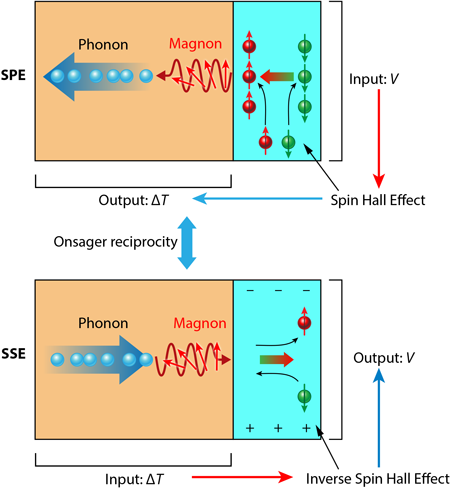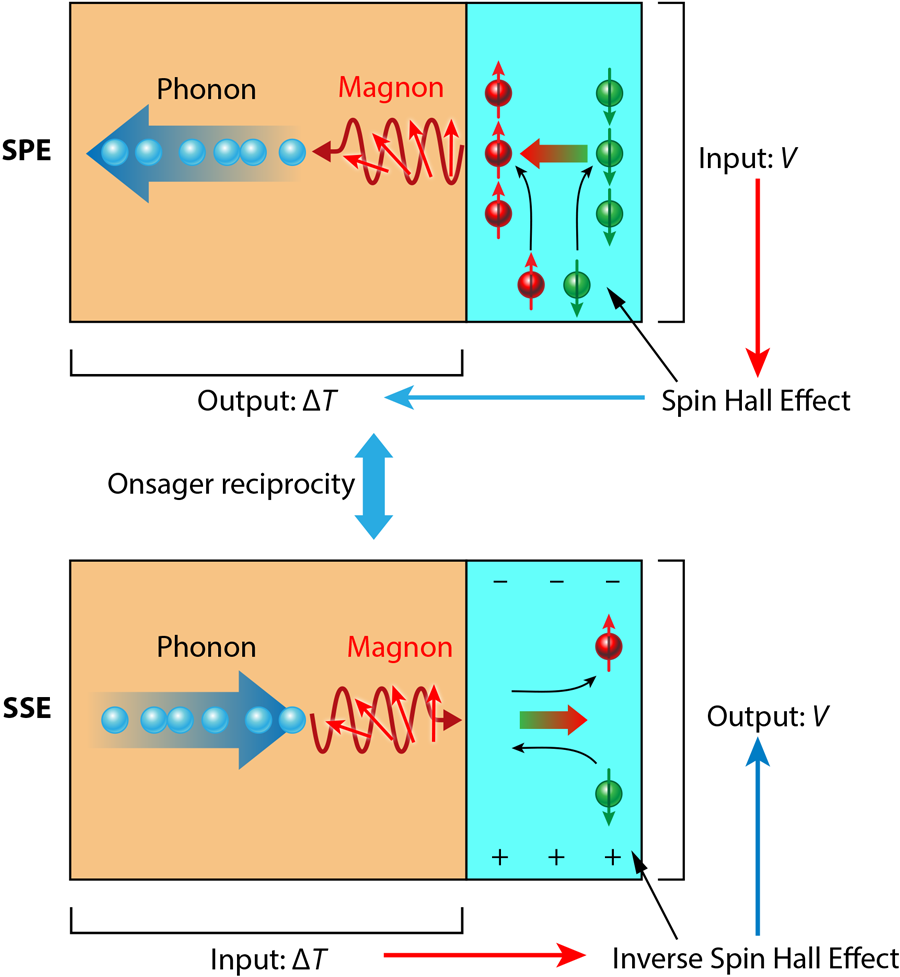Putting a New Spin on Heat Flow
Thermoelectric effects convert temperature differences into electric current, or vice versa, and are the basis of certain temperature sensors and heat pumps. However, other effects become available when spin is introduced. The field of thermal spin transport arose in 2008, when researchers demonstrated the spin Seebeck effect (SSE) by passing a heat current through a ferromagnet and recording an induced spin current in an adjacent metal [1]. This observation marked perhaps the first truly new transport effect discovered since the thermomagnetic (Nernst, Ettingshausen) effects in the late 1880s. Similarly to conventional thermoelectric effects, researchers anticipated that a reciprocal effect might exist, in which a temperature difference can be generated in a magnetic material by injecting a spin current from an adjacent metal. The first-ever observation of this so-called spin Peltier effect (SPE) is reported in Physical Review Letters [2]. Joost Flipse, of the University of Groningen in the Netherlands, and colleagues also confirmed that the SPE bears a fundamental thermodynamic relation with SSE, thus giving a solid experimental basis for the very young field of thermal spin transport (or “spin caloritronics” [3,4]). This opens up new possibilities for developing solid-state heat pumps and temperature control devices, which have long been a desirable yet elusive alternative to bulky mechanical processes like vapor compression.
The classical Seebeck effect involves the conversion of a temperature difference into a voltage, whereas its reciprocal effect, the classical Peltier effect, goes the other direction in turning a voltage into a temperature difference. These two thermoelectric effects follow the so-called Onsager reciprocity relation [5], in which the two rates of conversion have a well-defined ratio. Onsager reciprocity holds for all irreversible thermodynamic processes (i.e., transport effects), regardless of the specific mechanisms that drive them. In the case of thermal spin transport, Onsager reciprocity imposes an exact relation between SSE and SPE. According to this relation, one expects the SPE will typically be small and therefore swamped by Joule heating. And the same is true for other Peltier-like effects, which is why direct observation of both reciprocal relations in thermal transport measurements is generally an experimental tour de force [6]. (Note that Flipse and colleagues [7] recently observed the spin-dependent Peltier effect and the reciprocal spin-dependent Seebeck effect, which are similar to SPE and SSE but arise from completely different physics.)
Flipse et al. demonstrated the SPE in a system (see Fig. 1, top) consisting of a thin strip of platinum ( ) deposited along the surface of a magnetic film (here, an electrically insulating ferrimagnetic oxide called yttrium iron garnet, or “YIG”). An external magnetic field set the YIG magnetization, and thermopile sensors tracked the temperature difference in the film. The team applied a voltage across the platinum strip, which generated—via the spin Hall effect (SHE)—a transverse electronic spin accumulation on the platinum side of the Pt-YIG interface. This spin accumulation produced a magnetic force or “spin transfer torque” that acted on the electrons in the magnetically ordered Fe orbitals on the YIG side of the interface. Unlike the free-moving spin carriers in platinum, the Fe electrons are fixed, but they can still carry a spin current through spin waves called magnons. Thanks to the spin transfer torque, the platinum electrons were able to transfer energy and momentum to the YIG magnons, and vice versa, depending on the relative orientation of the Pt spin accumulation and the YIG magnetization.
Because magnons carry entropy as well as spin, the magnon flux in Flipse et al.’s experiment resulted in a heat flow in the YIG. However, the temperature sensors don’t measure spin perturbations but instead measure atomic vibrations, or phonons, so it’s only after the YIG magnons exchange energy with the YIG phonons that the heat flow becomes observable. The researchers were able to isolate the SPE heat flow from other much larger effects (like Joule heating) by altering the orientation of the YIG magnetization. With one orientation, heat flows out of the platinum and into the YIG, whereas the opposite orientation results in heat flowing from the YIG to the platinum. By comparing the temperature readings in both cases, the team found the SPE temperature difference , which is induced by the voltage applied to the adjacent metal.
To further confirm their observations, Flipse et al. reformulated their experiment to measure the SSE and verify that the Onsager relations are satisfied. In SSE, the entire process is reversed (see Fig. 1, bottom): the temperature difference induces a phonon flux, which couples to the magnons. The thermally driven magnon flux then interacts with the electrons in Pt, creating a net spin polarization in Pt at the interface, which in turn results in a voltage by the inverse spin Hall effect. The net result is the SSE: a temperature difference applied to one material (YIG) results in a voltage in the other material (Pt), the reciprocal effect to the SPE. The researchers confirm that the reciprocal relations hold, thus providing a strong argument that the signals are due to SSE and SPE and not to contaminations from classical thermomagnetic effects, such as the Nernst effect. The verification of the Onsager relations lends credence to the field of thermal spin transport as a whole.
As for applications, these are early and fundamental results still far from being used in devices. Yet, much like how SSE provides a new approach to solid-state heat-to-electricity conversion, SPE may be useful for solid-state heat pumps. Previous research has shown that the SSE is not necessarily small, and values as large as those of classical charge Seebeck coefficients have been observed in semiconductors in which electrons are spin polarized by the Zeeman effect [8]. Therefore, it’s conceivable that a large SPE could be engineered for applications. SPE heat pumps would have transverse geometries akin to those of Ettingshausen coolers or transverse Peltier coolers [9], where heat flux and charge current are normal to each other. For transverse geometries, the physical dimensions of the device can be separately changed to modulate the device output; for example, increasing the length of the Pt strip on an SSE generator increases the voltage supplied by the device independently of the temperature drop across it, while increasing the width of the magnetic film would similarly increase the refrigeration capacity in an SPE cooler. In conventional Peltier coolers or charge Seebeck generators, on the other hand, device design is more complex because the gradients and fluxes are parallel to one another and therefore can’t be modulated individually with simple changes in geometry. For a more detailed analysis of the physics and possible applications of SSE, we encourage the reader to examine our recent review in Ref. [3].
These alternative approaches to solid-state heating and cooling based on thermal spin transport remain for now at the fundamental research stage, where we are still concerned with basic goals like proving the underlying physical effects. In so doing, we must all be careful not to overextend the analysis of new observations: Even Seebeck himself originally mistook his namesake effect as originating from magnetic interactions. As this field begins to settle and cure into solid scientific understanding, however, we can use these results to guide engineering-focused projects like materials development and device optimization en route to exploring thermal spin transport as a basis for energy conversion technologies.
References
- K. Uchida, S. Takahashi, K. Harii, J. Ieda, W. Koshibae, K. Ando, S. Maekaw, and E. Saitoh, “Observation of the Spin Seebeck Effect,” Nature 455, 778 (2008)
- J. Flipse, F. K. Dejene, D. Wagenaar, G. E. W. Bauer, J. Ben Youssef, and B. J. van Wees, “Observation of the Spin Peltier Effect for Magnetic Insulators,” Phys. Rev. Lett. 113, 027601 (2014)
- S. R. Boona, R. C. Myers, and J. P. Heremans, “Spin Caloritronics,” Energy Environ. Sci. 7, 885 (2014)
- G. E. W. Bauer, E. Saitoh, and B. J. van Wees, “Spin Caloritronics,” Nature Mater. 11, 391 (2012)
- L. Onsager, “Reciprocal Relations in Irreversible Processes. I,” Phys. Rev. 37, 405 (1931); “Reciprocal Relations in Irreversible Processes. II,” 38, 2265 (1931)
- J. P. Heremans, C. M. Thrush, and D. T. Morelli, “Geometrical Magnetothermopower in Semiconductors,” Phys. Rev. Lett. 86 2098 (2001)
- J. Flipse, F. L. Bakker, A. Slachter, F. K. Dejene, and B. J. van Wees, “Direct Observation of the Spin-Dependent Peltier Effect,” Nature Nanotech. 7, 166 (2012)
- C. M. Jaworski, R. C. Myers, E. Johnston-Halperin, and J. P. Heremans, “Giant Spin Seebeck Effect in a Non-Magnetic Material,” Nature 487, 210 (2012)
- J. L. Cohn, S. Moshfeghyeganeh, C. A. M. dos Santos, and J. J. Neumeier, “Extreme Thermopower Anisotropy and Interchain Transport in the Quasi-One-Dimensional Metal LiMoO,” Phys. Rev. Lett. 112, 186602 (2014)





